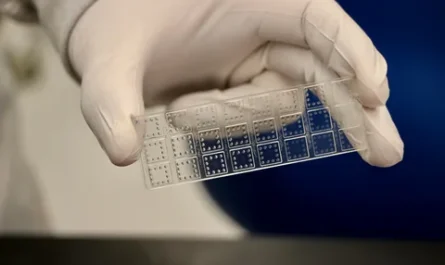A groundbreaking needle-free vaccine patch is under development to provide protection against the Zika virus, a serious mosquito-borne illness. Researchers at The University of Queensland and Vaxxas have successfully tested a prototype of the high-density microarray patch (HD-MAP), which effectively delivered a vaccine developed by the University of Adelaide, resulting in an immune response against the Zika virus in mice. These findings have been published in Molecular Therapy—Nucleic Acids.
Dr. Danushka Wijesundara, a researcher at Vaxxas and a former student at The University of Queensland, emphasized the widespread risk of Zika virus across various regions, including the Pacific, Southeast Asia, India, Africa, and South and Central America. He explained that the HD-MAP patch could revolutionize the approach to combating Zika virus due to its effectiveness, pain-free application, simplicity, and easy storage.
The HD-MAP patch is designed to deliver the vaccine directly to immune cells beneath the skin’s surface through thousands of tiny microprojections. In the preclinical trial, the vaccine provided rapid protection against the live Zika virus by targeting a protein called NS1, which is vital to the virus’s survival. Notably, the vaccine patch elicited T-cell responses that were approximately 270% higher compared to traditional needle or syringe delivery.
Zika virus usually causes mild symptoms, but it can have severe consequences for pregnant women, including miscarriage, stillbirths, or infants born with birth defects. In February 2016, the World Health Organization declared a Public Health Emergency of International Concern when the virus spread across 40 countries in Latin America, resulting in more than 1.5 million confirmed or suspected cases within a span of six months. Currently, there is no licensed vaccine available against Zika virus.
Associate Professor Branka Grubor-Bauk from The University of Adelaide highlighted the unique nature of this vaccine, as it targets a protein within the virus rather than on its surface. This approach ensures that vaccinated individuals do not experience symptom enhancement when exposed to closely related viruses such as dengue fever.
Dr. David Muller from The University of Queensland’s School of Chemistry and Molecular Biosciences explained that the HD-MAP patch and the vaccine could have wider applications beyond Zika virus protection. Since the targeted protein is crucial to the replication of flaviviruses, the approach could be extended to other flaviviruses like dengue or Japanese encephalitis. Furthermore, the HD-MAP patch has the potential to deliver a vaccine mixture that could protect against the entire family of viruses.
One key advantage of the HD-MAP delivery platform is the stability of vaccines at elevated temperatures. The researchers discovered that the patch retained vaccine potency even when stored at 40° Celsius for up to four weeks. This feature is particularly beneficial for low- and middle-income countries where refrigeration infrastructure is limited, enabling wider access to life-saving vaccines.
Overall, the needle-free vaccine patch utilizing the HD-MAP technology shows promise in combatting the Zika virus. Its pain-free application, simplicity, and vaccine stability at higher temperatures make it a potentially game-changing solution for protecting populations in at-risk regions. Moreover, the ability to target multiple viruses within the flavivirus family opens up new possibilities for preventing other significant diseases. Further research and development are necessary to advance this innovative solution and make it available for public use.
*Note:
- Source: Coherent Market Insights, Public sources, Desk research
- We have leveraged AI tools to mine information and compile it


